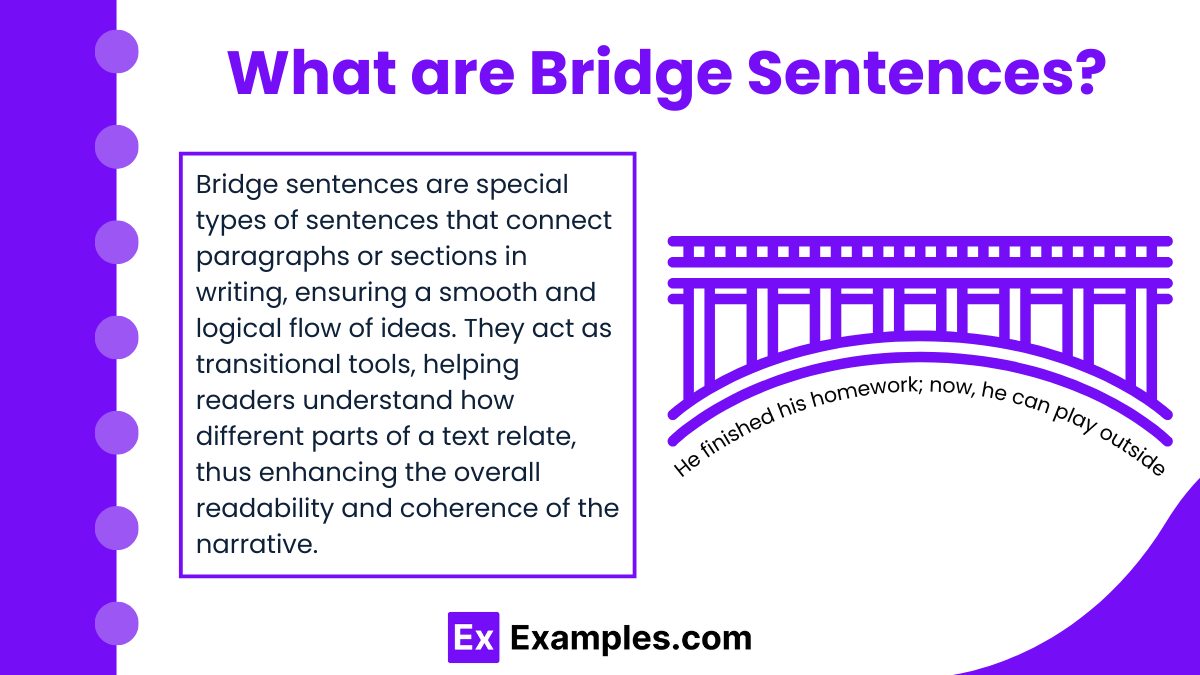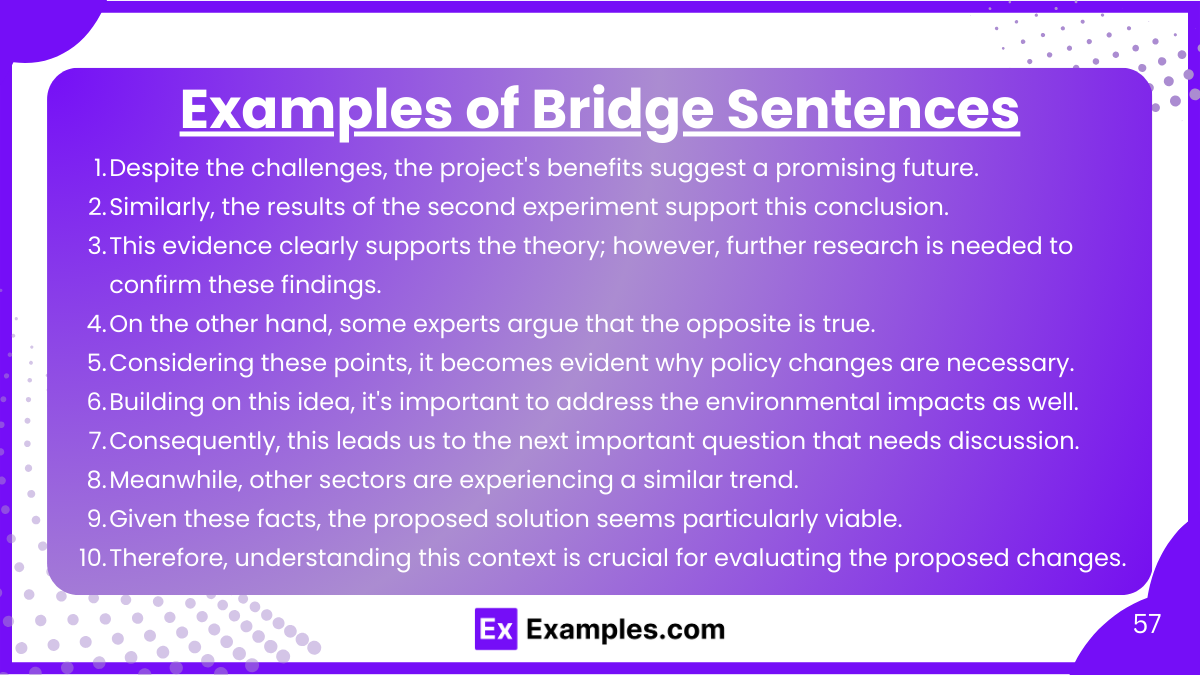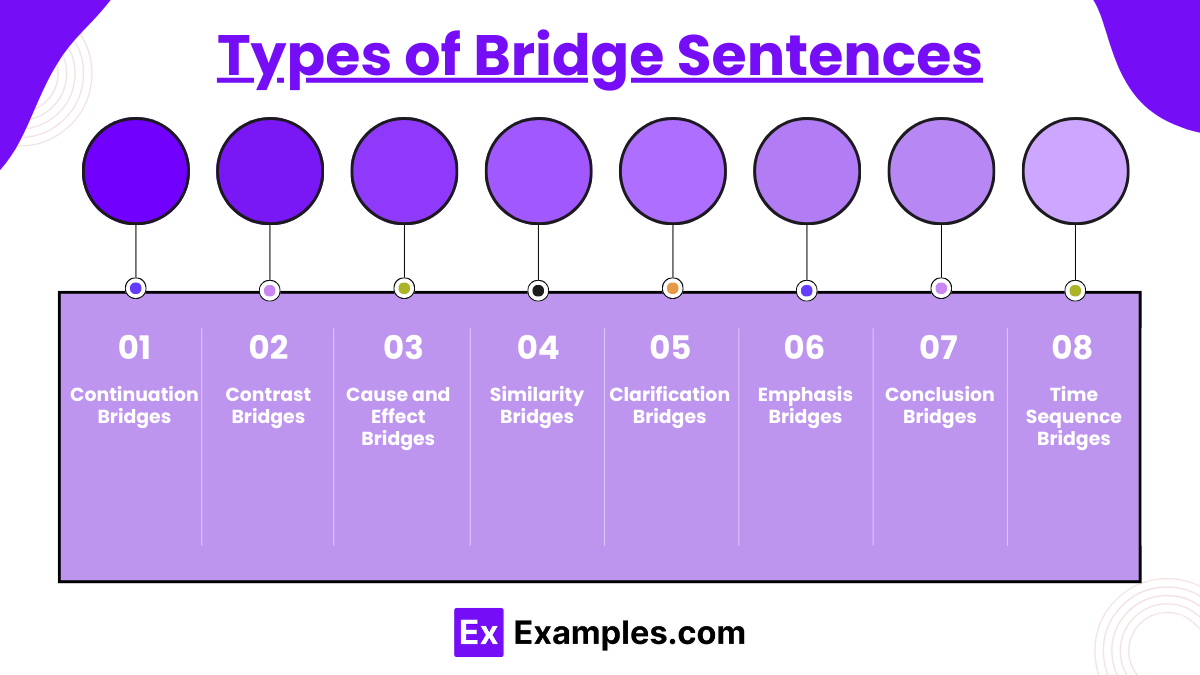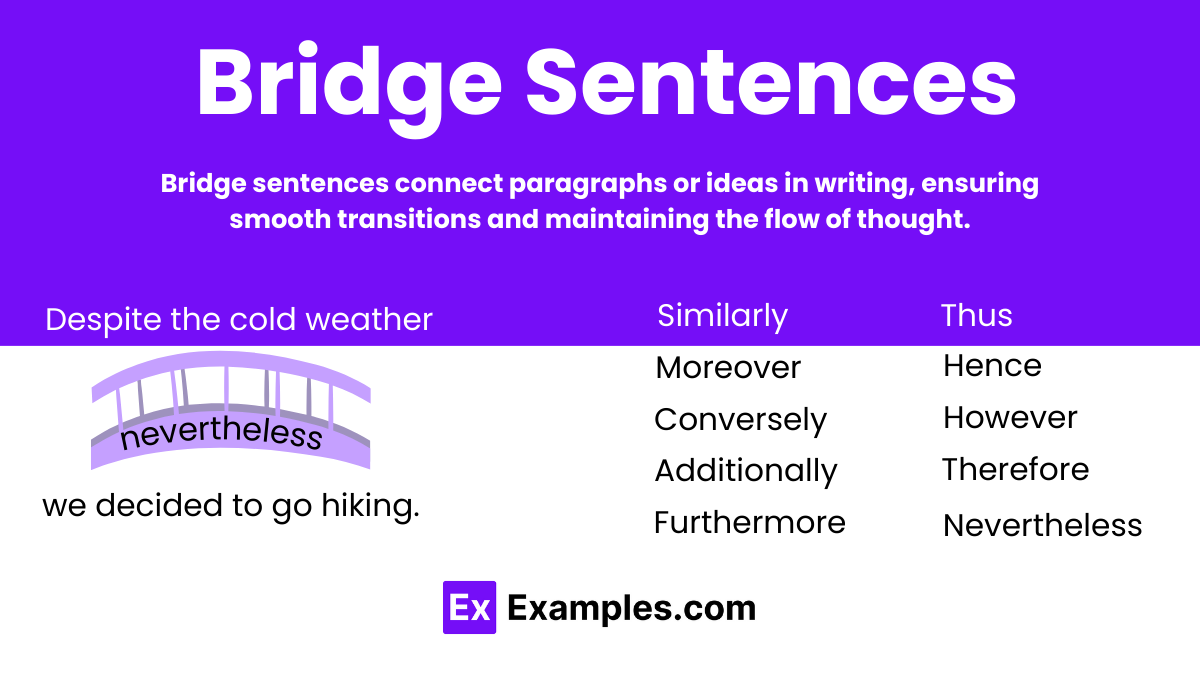90+ Bridge Sentence Examples
Bridge sentences are crucial tools in writing that help connect ideas smoothly and clearly. They serve as transitions between paragraphs or sections, ensuring that your content flows logically. By using bridge sentences, writers can guide readers through their arguments, making the text more cohesive and understandable. Whether you’re crafting an essay, article, or any written piece, mastering bridge sentences can significantly enhance the readability and effectiveness of your work.
What are Bridge Sentences?

Examples of Bridge Sentences

- Despite the challenges, the project’s benefits suggest a promising future.
- Similarly, the results of the second experiment support this conclusion.
- This evidence clearly supports the theory; however, further research is needed to confirm these findings.
- On the other hand, some experts argue that the opposite is true.
- Considering these points, it becomes evident why policy changes are necessary.
- Building on this idea, it’s important to address the environmental impacts as well.
- Consequently, this leads us to the next important question that needs discussion.
- Meanwhile, other sectors are experiencing a similar trend.
- Given these facts, the proposed solution seems particularly viable.
- Therefore, understanding this context is crucial for evaluating the proposed changes.
Bridge Examples for Kids
- First we went to the zoo; next, we’ll go to the playground.
- She loves to read books because they take her on adventures.
- He finished his homework; now, he can play outside.
- I like cats very much; similarly, my sister adores dogs.
- Winter is cold and snowy; on the other hand, summer is warm and sunny.
- We learned about planets in school today; tomorrow, we’ll explore stars.
- She was very tired; therefore, she went to bed early.
- Billy had a great time at the party; consequently, he didn’t want to leave.
- It was raining outside, so we decided to paint pictures indoors instead.
- Karen won the race because she practiced every day.
- After we finished our lunch, we went to the playground to meet our friends
Bridge Sentences in Essays
- Introduction to Body: “Having discussed the historical context, we now turn to examine the current implications of these events.”
- Between Body Paragraphs: “While the previous paragraph highlighted the causes of climate change, the following section will focus on its effects on global ecosystems.”
- Before a Contrasting Idea: “Contrary to the popular belief outlined above, recent studies present a different perspective.”
- Adding Supporting Information: “Furthermore, this argument is supported by data from a recent study, which shows…”
- Before a Conclusion: “Given these points, we are now in a position to draw conclusions about the effectiveness of the policy.”
- Summarizing a Point: “Thus, the evidence clearly indicates the need for further research.”
- Introducing an Example: “For instance, consider the case of…”
- Linking to a Broader Context: “This local issue mirrors a global trend that affects many other communities.”
- Leading into a Solution: “To address these challenges, one viable solution is…”
- Transitioning to a New Subtopic: “Having established the framework, let’s explore the specific strategies involved.”
Bridge Sentences for Class 1
- Now, let’s talk about something else.
- Next, we are going to learn about…
- Let’s move on to our next fun fact.
- After that, we did… Now, we will do…
- First we learned about A, now let’s look at B.
- Do you remember what we did yesterday? Today, we’re going to learn more about it.
- We finished our story, now let’s draw a picture of our favorite part.
- We counted apples before. Now, let’s count oranges.
- Let’s put away our books and get out our art supplies.
- We sang a song about the weather, now let’s look outside to see what the weather is doing today.
Bridge Sentences for Class 2
- We just read about animals. Now, let’s write our own story about a lion.
- We finished our math worksheet. Next, we’ll use blocks to show what we learned.
- We learned how plants grow. Let’s draw pictures of a plant’s life cycle.
- After playing our counting game, now we will count all the chairs in our classroom.
- We talked about the weather yesterday. Today, we’ll make a weather chart.
- First, we learned about addition. Now, let’s try some subtraction problems.
- Now that we’ve cleaned up our area, let’s gather around for story time.
- We’ve just finished learning our new words. Let’s use them in sentences now.
- We colored pictures in the morning; now, let’s write about the pictures after lunch.
- We talked about healthy foods; next, we will cut out pictures of foods to make our own healthy meal.
Bridge Sentences for Class 3
- Now that we’ve read about dinosaurs, let’s compare them to animals living today.
- We just learned about multiplication. Let’s apply it by calculating how many apples are in these baskets.
- After discussing the water cycle, let’s create a mini water cycle model in class.
- We’ve written our own fairy tales. Now, let’s read them aloud to the class.
- We’ve explored maps of our country. Next, let’s look at maps of other countries and find the differences.
- Now that we know how to measure length, let’s find objects around the classroom to practice measuring.
- We learned about ancient Egypt; now let’s write a day in the life of an Egyptian child.
- After our lesson on planets, let’s use balls of different sizes to create a model of the solar system.
- We discussed the importance of recycling; now, let’s sort these materials into recyclables and non-recyclables.
- We’ve practiced fractions with pizza slices; next, let’s use the same idea with a chocolate bar.
Short Bridge Sentences
- Moving from historical context to current applications, it’s clear that this technology has evolved significantly.
- On a related note, this brings us to another significant aspect.
- However, this perspective changes when we look at the situation from a different angle.
- Furthermore, this development has implications for both our short-term strategies and long-term goals.
- Conversely, critics argue that this approach may overlook some fundamental concerns.
- Building upon this point, we can see how it directly influences other trends in the field.
- Despite these advancements, several challenges remain unresolved.
- Next, let’s turn our attention to the effects of these changes.
- To better understand this phenomenon, a closer examination of the data is necessary.
Good Bridge Sentences
- This brings us to the next key point, which expands on our understanding of the issue.
- Consequently, we can see how this directly influences the outcomes discussed earlier.
- Similarly, another aspect to consider is the way this impacts related situations.
- This contrast highlights the complexity of the problem at hand.
- Building on this idea, it is essential to delve deeper into the implications.
- Moreover, this development sheds light on previously overlooked details.
- As a result, a new perspective emerges that challenges our prior assumptions.
- Therefore, a thorough examination of this element is crucial for a complete analysis.
- Subsequently, this leads to a broader discussion about the potential solutions.
- In light of these facts, reevaluating our approach becomes necessary.
- Given these connections, further exploration of this topic is warranted.
- Thus, drawing from the data, we can infer the broader trends at play.
Simple Bridge Sentences
- Let’s now consider another aspect of the same issue.
- This leads us to the next point.
- Similarly, we see a related pattern emerging in other areas.
- Contrasting with this idea, another perspective highlights a different issue.
- With this in mind, we can further explore the implications.
- This sets the stage for understanding the broader impact.
- Moreover, this connection is crucial for our discussion.
- This example clearly illustrates the main point.
- Turning to a different example, we can see how this applies in other contexts.
- To delve deeper, let’s examine a specific case.
Words to Start Bridge Sentences
| Additionally | Furthermore | Moreover | Conversely | Similarly |
| As a result | Subsequently | Therefore | Thus | Hence |
| On the other hand | Consequently | Nevertheless | However | Next |
| Following this | Meanwhile | Then | Accordingly | To illustrate |
| In contrast | On a similar note | Leading on from | In addition to | Before moving on |
| Finally | Initially | In conclusion | As previously stated | Moreover |
Types of Bridge Sentences

1. Continuation Bridges
- These sentences extend the thought from the previous paragraph or introduce additional information that complements the preceding ideas.
- Example: “Furthermore, continuing this program will not only benefit current participants but also future generations.”
2. Contrast Bridges
- Used to introduce a contrasting or opposing viewpoint to the one just discussed, helping to highlight differences.
- Example: “However, despite the previous success of the initiative, recent reports suggest a decline in its effectiveness.”
3. Cause and Effect Bridges
- These bridge sentences explain the cause and effect relationships between ideas, showing how one event leads to another.
- Example: “Consequently, the sudden drop in temperature last winter caused significant damage to the crop yields.”
4. Similarity Bridges
- They draw parallels between two ideas, emphasizing similarities and connections.
- Example: “Similarly, the economic policies of Country X have mirrored the early stages of economic development seen in Country Y.”
5. Clarification Bridges
- These are used to clarify or further explain a point or idea that might not have been fully understood.
- Example: “To clarify, the new policy does not replace the old one but rather expands upon the existing regulations.”
6. Emphasis Bridges
- Emphasis bridges are employed to stress the importance or critical nature of a point just discussed.
- Example: “Indeed, this evidence highlights the urgent need for reform within the sector.”
7. Conclusion Bridges
- Used to signal that a conclusion or summary is forthcoming, wrapping up the discussion.
- Example: “In conclusion, the multiple benefits of this approach clearly outweigh its drawbacks.”
8. Time Sequence Bridges
- These help organize narratives or processes by marking the progression of time or steps.
- Example: “Subsequently, after the initial trials were successful, the next phase of the project commenced.”
How to Write Bridge Sentences

1. Understand the Purpose of Bridge Sentences
- Transition: Bridge sentences help readers move from one paragraph or section to another seamlessly.
- Prediction: They can set the stage for what is coming next, preparing the reader for a shift in tone, argument, or topic.
- Reflection: Bridge sentences can also reflect on the content just covered, making a connection between the previous information and new ideas.
2. Identify the Connection
- Start by clearly understanding the content of both the preceding and following paragraphs.
- Identify the key elements that connect these two paragraphs. This could be a shared theme, a contrasting point, or a cause-and-effect relationship.
3. Choose the Right Type of Transition
- Continuation transitions (furthermore, moreover, additionally) are used when adding similar information or expanding on a point.
- Contrast transitions (however, on the other hand, conversely) introduce an opposing viewpoint or a shift in direction.
- Cause and effect transitions (therefore, as a result, thus) demonstrate the relationship between actions and outcomes.
- Chronological transitions (next, then, after) are useful in narrative or process writing to show the progression of time or steps.
4. Craft the Sentence
- Keep the bridge sentence concise and to the point.
- Use it to gently guide the reader from one idea to the next, ensuring the sentence fits the tone and style of your writing.
- Make sure it incorporates key terms or concepts that are central to both paragraphs, enhancing the thematic continuity of your text.
5. Evaluate its Effectiveness
- After writing your bridge sentence, read the transition aloud to see if it naturally guides you from one idea to the next.
- Check if the bridge sentence helps clarify the relationship between paragraphs. If the connection still feels jarring or abrupt, consider revising the sentence.
FAQs
Why are bridge sentences used?
Bridge sentences connect paragraphs or sections, ensuring a smooth transition in writing, aiding coherence, and guiding readers from one idea to another seamlessly.
What is a bridge sentence in analogies?
In analogies, a bridge sentence explains the relationship between two seemingly unrelated topics, clarifying how one idea or example parallels or contrasts with another.
How to use the verb bridge in a sentence?
The verb “bridge” denotes the act of making connections or overcoming gaps; e.g., “This meeting aims to bridge the communication gap between departments.”
What are good bridge sentences?
Good bridge sentences effectively link ideas, clarify transitions, and maintain the flow of text, often incorporating transitional phrases like ‘furthermore’, ‘however’, or ‘consequently’.



